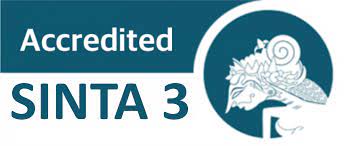NATURAL LANGUAGE PROCESSING-BASED BLENDED LEARNING IN THE EFL FLIPPED CLASSROOM: A CONCEPTUAL FRAMEWORK AND PROPOSED DESIGNS
Abstract
The use of Natural Language Processing (NLP) in the English as a Foreign Language (EFL) flipped classroom has the potential to support blended learning and enhance learner autonomy and language development. However, there is a need for more research on the use of NLP in the EFL flipped classroom. This paper addresses this research gap by proposing a conceptual framework for using NLP in the EFL flipped classroom and a set of proposed designs and activities incorporating NLP to enhance learner autonomy and language development. This paper aims to provide a conceptual framework for using NLP in the EFL flipped classroom and propose a set of designs and activities incorporating NLP to enhance learner autonomy and language development. This paper's methodology involves reviewing the literature on NLP and the flipped classroom and developing a conceptual framework and proposed designs and activities. The product of this paper is a conceptual framework for using NLP in the EFL flipped classroom to support blended learning and a set of proposed designs and activities that incorporate NLP to enhance learner autonomy and language development. This paper concludes that NLP has the potential to support blended learning and enhance learner autonomy and language development in the EFL flipped classroom. However, further research is needed to evaluate these approaches' effectiveness and identify best practices for using NLP in the EFL flipped classroom.
Keywords
Full Text:
PDFReferences
Abdullah, M. Y., Hussin, S., & Ismail, K. (2019). Implementation of Flipped Classroom Model and Its Effectiveness on English Speaking Performance. International Journal of Emerging Technologies in Learning, 14(9). Afzali, Z., & Izadpanah, S. (2021). The effect of the flipped classroom model on Iranian English foreign language learners: Engagement and motivation in English language grammar. Cogent Education, 8(1), 1870801. Afzali, Z., & Izadpanah, S. (2021). The effect of the flipped classroom model on Iranian English foreign language learners: Engagement and motivation in English language grammar. Cogent Education, 8(1), 1870801. Ahmed, M. M. H., & Indurkhya, B. (2020). Investigating cognitive holding power and equity in the flipped classroom. Heliyon, 6(8), e04672. Alamri, H. A., Watson, S., & Watson, W. (2021). Learning technology models that support personalization within blended learning environments in higher education. TechTrends, 65(1), 62-78. Alsowat, H. (2016). An EFL flipped classroom teaching model: Effects on English language higher-order thinking skills, student engagement and satisfaction. Journal of Education and Practice, 7(9), 108-121. Artal-Sevil, J. S. (2019). Flipped Teaching and Game-based Learning in higher education: the Good, the Bad and the Ugly. In ICERI2019 Proceedings (pp. 9271-9280). IATED. Basal, A. (2015). The implementation of a flipped classroom in foreign language teaching. Turkish online journal of distance education, 16(4), 28-37. Bond, M. (2020). Facilitating student engagement through the flipped learning approach in K-12: A systematic review. Computers & Education, 151, 103819. Brewer, R., & Movahedazarhouligh, S. (2018). Successful stories and conflicts: A literature review on the effectiveness of flipped learning in higher education. Journal of Computer Assisted Learning, 34(4), 409-416. Chen, M. R. A., & Hwang, G. J. (2020). Effects of a concept mapping‐based flipped learning approach on EFL students’ English speaking performance, critical thinking awareness and speaking anxiety. British Journal of Educational Technology, 51(3), 817-834. Chuang, H. H., Weng, C. Y., & Chen, C. H. (2018). Which students benefit most from a flipped classroom approach to language learning?. British Journal of Educational Technology, 49(1), 56-68. Day, T., & Tosey, P. (2011). Beyond SMART? A new framework for goal setting. Curriculum Journal, 22(4), 515-534. Green, T. (2015). Flipped classrooms: An agenda for innovative marketing education in the digital era. Marketing Education Review, 25(3), 179-191. Haghighi, H., Jafarigohar, M., Khoshsima, H., & Vahdany, F. (2019). Impact of flipped classroom on EFL learners' appropriate use of refusal: achievement, participation, perception. Computer Assisted Language Learning, 32(3), 261-293. Ishak, T., Kurniawan, R., Zainuddin, Z., & Keumala, C. M. (2020). The Role of Pre-Class Asynchronous Online Video Lectures in Flipped-Class Instruction: Identifying Students' Perceived Need Satisfaction. Journal of Pedagogical Research, 4(1), 1-11. Ismail, S. S., & Abdulla, S. A. (2019). Virtual flipped classroom: New teaching model to grant the learners knowledge and motivation. Journal of Technology and Science Education, 9(2), 168-183. Joty, S., Carenini, G., Ng, R., & Murray, G. (2019). Discourse analysis and its applications. In Proceedings of the 57th Annual Meeting of the Association for Computational Linguistics: Tutorial Abstracts (pp. 12-17). Kurt, G. (2017). Implementing the flipped classroom in teacher education: Evidence from Turkey. Journal of Educational Technology & Society, 20(1), 211-221. Lai, H. M. (2021). Understanding what determines university students’ behavioral engagement in a group-based flipped learning context. Computers & Education, 173, 104290. Latorre-Cosculluela, C., Suárez, C., Quiroga, S., Sobradiel-Sierra, N., Lozano-Blasco, R., & Rodríguez-Martínez, A. (2021). Flipped Classroom model before and during COVID-19: using technology to develop 21st century skills. Interactive Technology and Smart Education, 18(2), 189-204. Lee, Y. J., Davis, R., & Li, Y. (2022). Implementing Synchronous Online Flipped Learning for Pre-Service Teachers during COVID-19. European Journal of Educational Research, 11(2), 653-661. Li, Z., & Li, J. (2022). Using the Flipped Classroom to Promote Learner Engagement for the Sustainable Development of Language Skills: A Mixed-Methods Study. Sustainability, 14(10), 5983. Lo, C. K., & Hew, K. F. (2021). Developing a flipped learning approach to support student engagement: A design‐based research of secondary school mathematics teaching. Journal of Computer Assisted Learning, 37(1), 142-157. McCarthy, J. (2016). Reflections on a flipped classroom in first year higher education. Issues in Educational Research, 26(2), 332-350. Meera, S., & Geerthik, S. (2022). Natural language processing. Artificial Intelligent Techniques for Wireless Communication and Networking, 139-153. Mishra, B. K., & Kumar, R. (Eds.). (2020). Natural Language Processing in Artificial Intelligence. CRC Press. Nerantzi, C. (2020). The use of peer instruction and flipped learning to support flexible blended learning during and after the COVID-19 Pandemic. International Journal of Management and Applied Research, 7(2), 184-195. O'Flaherty, J., & Phillips, C. (2015). The use of flipped classrooms in higher education: A scoping review. The internet and higher education, 25, 85-95. Onodipe, G., & Ayadi, M. F. (2020). Using smartphones for formative assessment in the flipped classroom. Journal of Instructional Pedagogies, 23. Öztürk, M., & Çakıroğlu, Ü. (2021). Flipped learning design in EFL classrooms: implementing self-regulated learning strategies to develop language skills. Smart Learning Environments, 8(1), 1-20. Pokrivčáková, S. (2019). Preparing teachers for the application of AI-powered technologies in foreign language education. Journal of Language and Cultural Education. Rajaram, K. (2019). Flipped classrooms: Providing a scaffolding support system with real-time learning interventions. Asian Journal of the Scholarship of Teaching and Learning, 9(1), 30-58. Rodrigues, F., & Oliveira, P. (2014). A system for formative assessment and monitoring of students' progress. Computers & Education, 76, 30-41. Ruan, S., Willis, A., Xu, Q., Davis, G. M., Jiang, L., Brunskill, E., & Landay, J. A. (2019). Bookbuddy: Turning digital materials into interactive foreign language lessons through a voice chatbot. In Proceedings of the Sixth (2019) ACM Conference on Learning@ Scale (pp. 1-4). Senali, M. G., Iranmanesh, M., Ghobakhloo, M., Gengatharen, D., Tseng, M. L., & Nilsashi, M. (2022). Flipped classroom in business and entrepreneurship education: A systematic review and future research agenda. The International Journal of Management Education, 20(1), 100614. Shi, Y., Ma, Y., MacLeod, J., & Yang, H. H. (2020). College students’ cognitive learning outcomes in flipped classroom instruction: a meta-analysis of the empirical literature. Journal of Computers in Education, 7(1), 79-103. Velegol, S. B., Zappe, S. E., & Mahoney, E. M. I. L. Y. (2015). The Evolution of a Flipped Classroom: Evidence-Based Recommendations. Advances in Engineering Education, 4(3), n3. Wallace, M. L., Walker, J. D., Braseby, A. M., & Sweet, M. S. (2014). " Now, What Happens During Class?" Using Team-Based Learning to Optimize the Role of Expertise Within the Flipped Classroom. Journal on Excellence in College Teaching, 25. Wambsganss, T., Niklaus, C., Cetto, M., Söllner, M., Handschuh, S., & Leimeister, J. M. (2020). AL: an adaptive learning support system for argumentation skills. In Proceedings of the 2020 CHI Conference on Human Factors in Computing Systems (pp. 1-14). Wang, Y., & Qi, G. Y. (2018). Mastery-based language learning outside class: Learning support in flipped classrooms. Language Learning & Technology, 22(2), 50-74. Watson, J. (2008). Blended Learning: The Convergence of Online and Face-to-Face Education. Promising Practices in Online Learning. North American Council for Online Learning.
DOI: https://doi.org/10.18860/abj.v9i1.18795
Refbacks
- There are currently no refbacks.
Copyright (c) 2024 Risang Baskara

This work is licensed under a Creative Commons Attribution-NonCommercial 4.0 International License.
...............................................................................................................................................................
Mailing Address:
Ruang Jurnal Abjadia, Fakultas Ilmu Tarbiyah dan Keguruan (FITK)
Universitas Islam Negeri (UIN) Maulana Malik Ibrahim Malang
Jalan Gajayana 50 Malang 65144, Jawa Timur, Indonesia
Phone/Faximile: (+62341) 552398, Phonsel: +6281333666063
Website: http://ejournal.uin-malang.ac.id/index.php/abjadia
Email: abjadia@uin-malang.com
Abjadia: International Journal of Education. This work is licensed under a Creative Commons Attribution-ShareAlike 4.0 International License.
...............................................................................................................................................................
Indexed by:






